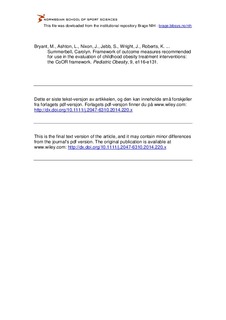| dc.contributor.author | Bryant, M. | |
| dc.contributor.author | Ashton, L. | |
| dc.contributor.author | Nixon, J. | |
| dc.contributor.author | Jebb, S. | |
| dc.contributor.author | Wright, J. | |
| dc.contributor.author | Roberts, K. | |
| dc.contributor.author | Brown, J. | |
| dc.contributor.author | Cooper, Ashley R. | |
| dc.contributor.author | Cummings, Steven | |
| dc.contributor.author | Ekelund, Ulf | |
| dc.contributor.author | Gorecki, Claudia | |
| dc.contributor.author | Griffiths, Lucy | |
| dc.contributor.author | Hamilton-Shield, Julian | |
| dc.contributor.author | Hill, Andrew | |
| dc.contributor.author | Kind, Paul | |
| dc.contributor.author | Reilly, John J. | |
| dc.contributor.author | Summerbell, Carolyn | |
| dc.date.accessioned | 2015-05-29T08:31:13Z | |
| dc.date.available | 2015-05-29T08:31:13Z | |
| dc.date.issued | 2014-04-14 | |
| dc.identifier.citation | Pediatric Obesity. 2014, 9, e116-e131 | nb_NO |
| dc.identifier.uri | http://hdl.handle.net/11250/284227 | |
| dc.description | I Brage finner du siste tekst-versjon av artikkelen, og den kan inneholde små forskjeller fra forlagets pdf-versjon. Forlagets pdf-versjon finner du på www.wiley.com: http://dx.doi.org/10.1111/j.2047-6310.2014.220.x / In Brage you'll find the final text version of the article, and it may contain minor differences from the journal's pdf version. The original publication is available at www.wiley.com: http://dx.doi.org/10.1111/j.2047-6310.2014.220.x | nb_NO |
| dc.description.abstract | Consensus is lacking in determining appropriate outcome measures for assessment of childhood obesity treatments. Inconsistency in the use and reporting of such measures impedes comparisons between treatments and limits consideration of effectiveness. This study aimed to produce a framework of recommended outcome measures: the Childhood obesity treatment evaluation Outcomes Review (CoOR) framework.
Methods: A systematic review including two searches was conducted to identify (1) existing trial outcome measures and (2) manuscripts describing development/evaluation of outcome measures. Outcomes included anthropometry, diet, eating behaviours, physical activity, sedentary time/behaviour, fitness, physiology, environment, psychological well-being and health-related quality of life. Eligible measures were appraised by the internal team using a system developed from international guidelines, followed by appraisal from national external expert collaborators.
Results: A total of 25 486 papers were identified through both searches. Eligible search 1 trial papers cited 417 additional papers linked to outcome measures, of which 56 were eligible. A further 297 outcome development/evaluation papers met eligibility criteria from search 2. Combined, these described 191 outcome measures. After internal and external appraisal, 52 measures across 10 outcomes were recommended for inclusion in the CoOR framework.
Conclusion: Application of the CoOR framework will ensure greater consistency in choosing robust outcome measures that are appropriate to population characteristics. | nb_NO |
| dc.language.iso | eng | nb_NO |
| dc.publisher | John Wiley & Sons | nb_NO |
| dc.subject | framework | nb_NO |
| dc.subject | outcome measures | nb_NO |
| dc.subject | quality | nb_NO |
| dc.subject | systematic review | nb_NO |
| dc.title | Framework of outcome measures recommended for use in the evaluation of childhood obesity treatment interventions: the CoOR framework | nb_NO |
| dc.type | Journal article | nb_NO |
| dc.type | Peer reviewed | nb_NO |
| dc.subject.nsi | VDP::Medical disciplines: 700::Health sciences: 800::Nutrition: 811 | nb_NO |
| dc.source.journal | Pediatric Obesity | nb_NO |
| dc.description.localcode | Seksjon for idretssmedisinske fag / Department of Sports Medicine | nb_NO |
